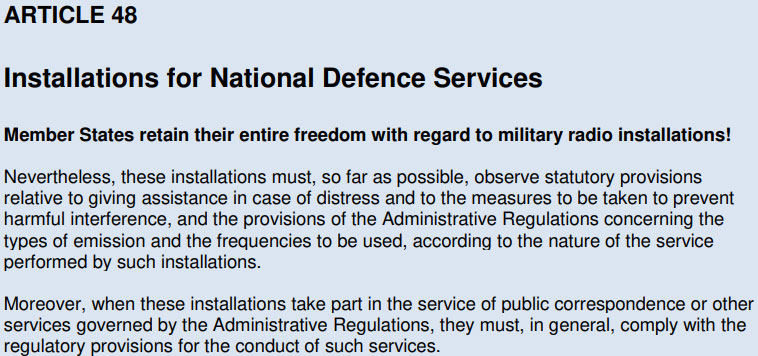 Article 48 of the ITU Constitution has been abused by nations that are conducting commercial broadcasts but, when challenged because of frequency interference or other reasons, use Article 48 to end the inquiry. It has also been used to disguise the fact that nations claiming to have a satellite network in orbit in a given frequency actually have nothing in orbit. Credit: ITU
Article 48 of the ITU Constitution has been abused by nations that are conducting commercial broadcasts but, when challenged because of frequency interference or other reasons, use Article 48 to end the inquiry. It has also been used to disguise the fact that nations claiming to have a satellite network in orbit in a given frequency actually have nothing in orbit. Credit: ITU
PARIS — The increased use of satellite networks for commercial and non-commercial applications may have the salutary effect of forcing the International Telecommunication Union (ITU) to put teeth into its regulations.
The ITU’s Radio Regulations Board has already shown signs that it can and will push back on some of the most egregious dodges its member nations use to flout the rules.
The most recent example: The infamous Article 48 of the ITU Constitution, which is designed to preserve maximum freedom for governments to use radio spectrum for military purposes.
Governments have invoked Article 48 when one of their registered satellite networks is suspected of missing its in-service deadlines. Instead of having to prove that it has a satellite beaming in the registered frequencies at the registered orbital slot, it escapes an investigation by saying: Article 48.
Another example: When a network suspected of interfering with another nation’s satellite, a government claims it’s for military use and the inquiry is left with nowhere to go, even if there’s strong evidence that the broadcasts in question are commercial.
The ITU’s World Radiocommunication Conference in 2019 (WRC-19) asked the Board to craft language that would make it more difficult to use Article 48 as a cloak Of invisibility.
On July 1, the Board agreed to forward to the ITU’s Plenipotentiary Conference (PP-22) language that would allow the ITU to investigate Article 48 claims.
The ITU already has the power to employ ground radars to determine if a satellite is actually where its owner says it is, and whether it’s broadcasting in the correct frequencies.
 Credit: ITU
Credit: ITU
PP-22 is scheduled for Sept. 26 to Oct. 14 in Bucharest. Plenipotentiary conferences are the ITU’s second-ranking venues, after the quadrennial WRCs.
The Board’s July 1 report said:
“The Board considered that invoking Article 48 for the sole purpose Of preventing the Bureau from investigating the status of satellite networks was incompatible with the Constitution and the Radio Regulations.
“Article 48 cannot be invoked for frequency assignments used by non-military radio installations or by both military and non-military radio installations.”
And now the teeth:
“BR and the Board can seek clarification and consequently apply all relevant regulatory provisions if it appears from reliable information that a recorded frequency assignment for which Article 48 has been involved is actually not in compliance therewith.”
And there’s this too: “[R]egardless of whether Article 48 is invoked, frequency assignments used by military radio installations are entitled to international recognition and the right to claim protection from harmful interference only if they are recorded in the MIFR,” the ITU’s Master International Frequency Registry.
If adopted by PP-22, this “clarification” of the ITU rules should allow the Board to use commercial technical means to determine what’s in orbit, and what frequencies it’s using, when there is reason to believe it’s not a military system.
As is the case for all regulatory bodies With little actual power, the ITU’s strength lies in shining a light on a given satellite network and asking the nations involved in the dispute to work things out on their own, with Board mediation.
Read more from Space Intel Report.
